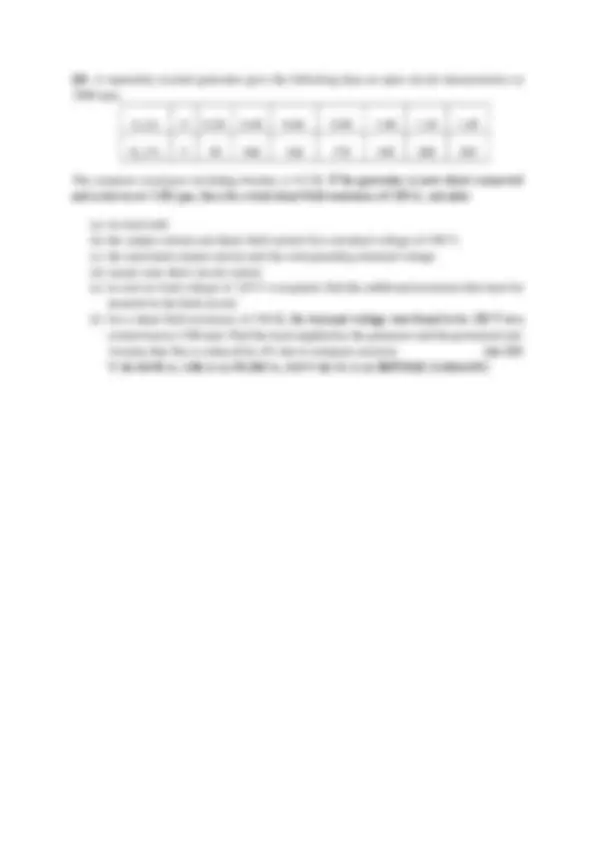



Study with the several resources on Docsity

Earn points by helping other students or get them with a premium plan


Prepare for your exams
Study with the several resources on Docsity

Earn points to download
Earn points by helping other students or get them with a premium plan
Community
Ask the community for help and clear up your study doubts
Discover the best universities in your country according to Docsity users
Free resources
Download our free guides on studying techniques, anxiety management strategies, and thesis advice from Docsity tutors
Basic Performance Equation for D.C. Machines, Magnetization Curve, Operating
Typology: Assignments
1 / 2

This page cannot be seen from the preview
Don't miss anything!


UEE3 06 Electro-Mechanical Energy Conversion TUTORIAL 3 (Basic Performance Equation for D.C. Machines, Magnetization Curve, Operating Characteristics of Separately Excited and Shunt D.C. Generators) Course Instructors: Dr. Prasenjit Basak & Dr. Amit Kumar Q1. A 250 V, 10 kW D.C. shunt generator has 1400 turns on each pole. At rated speed, a shunt field current of 2 A produces a no-load voltage of 250 V, but at rated load the same load voltage of 250 V can be produced by a field current of 2.2 A. It is required, not to change the field current for maintaining load voltage constant, but add a series field winding. Calculate the number of series field turns per pole required for long shunt connection. [Series field turns required = 7] Q 2. A separately excited generator, when running at 1200 RPM supplies 200 A at 125 V to a circuit of constant resistance. What will be the current when the speed is dropped to 1000 RPM if the field current is unaltered? Armature resistance is 0.04 Ω, total drop at brushes 2 V, ignore change in armature reaction. [166 A] Q 3. A 4-pole shunt generator with lap-connected armature having field and armature resistances of 50 Ω and 0.1 Ω respectively supplies 60 numbers 100 V, 40 W lamps. Calculate the total armature current, the current per armature path and the generated emf. Allow a constant drop of 1 V per brush. [26 A, 6.5 A, 104.6 V] Q 4. The following data pertain to the magnetization curve of a DC shunt generator at 1500 rpm. If (A) 0 0.4 0.8 1.20 1.60 2.00 2.40 2.80 3. Ea (V) 6 60 120 172.5 202.5 221 231 237 240 For this generator, obtain: (a) the voltage on open circuit to which the machine will build up (i.e. no-load emf) for a total shunt filed resistance of 100 Ω; (b) the critical value of shunt field resistance at 1500 rpm; (c) the critical speed for the shunt filed resistance of 100 Ω; (d) the magnetization curve at 1200 rpm and therefore the open circuit voltage for a field resistance of 100 Ω; (e) the terminal voltage of the generator if the total armature resistance is 0.3 Ω, armature current is 50 A and the speed is 1500 rpm. Neglect armature reaction. [(a) 230 V; (b) 150 Ω; (c) 1000 rpm; (d) 165 V (e) 207 V]
Q 5. A separately excited generator gave the following data on open circuit characteristics at 1000 rpm. If (A) 0 0.20 0.40 0.60 0.80 1.00 1.20 1. Ea (V) 5 50 100 140 170 190 200 205 The armature resistance including brushes is 0.5 Ω. If the generator is now shunt connected and is driven at 1100 rpm, then for a total shunt field resistance of 180 Ω, calculate: (a) no-load emf; (b) the output current and shunt field current for a terminal voltage of 190 V; (c) the maximum output current and the corresponding terminal voltage (d) steady state short circuit current (e) in case no-load voltage of 210 V is required, find the additional resistance that must be inserted in the field circuit; (f) for a shunt field resistance of 150 Ω, the terminal voltage was found to be 180 V at a certain load at 1100 rpm. Find the load supplied by the generator and the generated emf. Assume that flux is reduced by 4% due to armature reaction. [(a) 221 V (b) 43.94 A, 1.06 A (c) 92.365 A, 114 V (d) 11 A (e) 26.9 Ω (f) 11.016 kW]